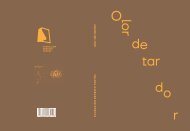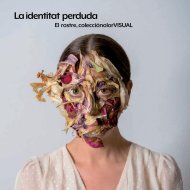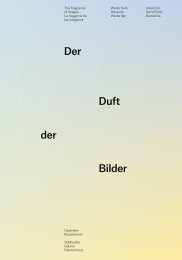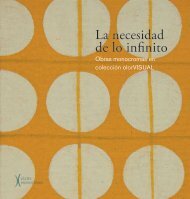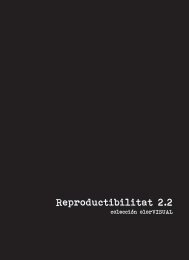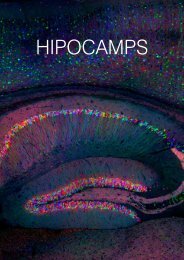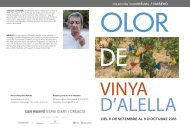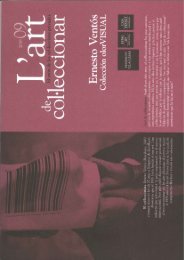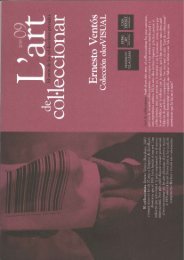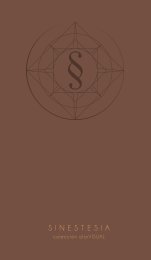24Electric
You also want an ePaper? Increase the reach of your titles
YUMPU automatically turns print PDFs into web optimized ePapers that Google loves.
Smell rebelled for one split second and I was deeply<br />
suffering. You might have had similar nostalgia being<br />
thrust upon you involuntarily.<br />
Smell’s strategy of rebellion is to use the inadequacies<br />
of our memories against us. Yet, ironically,<br />
the strategy manages to elucidate the captivity of the<br />
senses, rather than generate any liberation. Even the<br />
moment of defiance itself is dependent upon the existence<br />
of our experiences. Smell cannot escape the<br />
“I” in us any more than we can escape its desire to be<br />
rid of our purpose for it. We place suffering on smell<br />
so that we might suffer ourselves.<br />
Until we manipulate smell for our own use, it is<br />
merely a chemosensory phenomenon—a “non-sense”.<br />
Our primary reason for the subjectification of scent<br />
is so that it can have industrial or utilitarian purposes.<br />
Occasionally we enslave it for seductive or indulgent<br />
tangents (which may in the end be utilitarian as<br />
well). But we are never really interested in what smell<br />
would be without us.<br />
I can’t blame smell for trying to resist the mechanization<br />
of its essence any more than I can blame myself<br />
for resisting the absence of “I”. It would require<br />
me to sever my alliance to suffering.<br />
I accept that from time to time smell might inconveniently<br />
provoke my memories from their slumber. I<br />
am confident that this coup d’état will only result in<br />
the reassurance that my experiences and memories<br />
remain allied with my ego. Smell will always maintain<br />
its need to communicate through us—therefore,<br />
never really be able to liberate itself. This dependency<br />
is the perfect condition for human ego to continue<br />
to subjectify the senses.<br />
This duplicitous relationship ultimately denies my<br />
access to the true conscious center of self—universal<br />
knowing. But this impasse conveniently perpetuates<br />
the condition of my suffering. It is a romantic quest<br />
paying tribute to my desire for an anonymity that I<br />
know will never really exist.<br />
In précis—I am everything that chemosensory<br />
interactions represent in their purity and “I” am<br />
everything that corrupts their virginity. Smell was<br />
non-sense until I came along and it will be non-sense<br />
again when I am gone.<br />
50<br />
Juan Uslé<br />
De Llerana y Grammarland,<br />
‘In photography, the observer’s obsession is channelled<br />
through a gaze eager for smells and lights,<br />
linking the abstract with the real, enriching the landscape<br />
from an intimate perspective. These flashes of<br />
the everyday exist by way of the light and the darkness,<br />
to convey the sensation and the essence of an<br />
incomplete journey, of a tireless search.’<br />
Galeria Joan Prats, 2001<br />
51<br />
Lynne Cohen<br />
The pictures are a kind of archaeology of fixtures and<br />
furniture. You can almost tell from the smells associated<br />
with the places I photographed. The early work<br />
conjures up smells of ashtrays filled with cigarette<br />
butts, empty beer bottles, Freon, wet dog hair and<br />
air freshener. The later work conjures up smells of<br />
chlorine, metal electric wires, gasoline, plywood and<br />
formaldehyde. The smell of linoleum is a constant so<br />
this method is not entirely reliable.<br />
Also the early work is funnier, messier, more symmetrical,<br />
warmer and less threatening; the later work<br />
colder, tidier and more disquieting<br />
Smells in my early work:<br />
Ashtrays filled with cigarette butts<br />
Old wax<br />
Unwashed empty beer bott<br />
Dog hair on wet carpet<br />
Baby powder air freshener<br />
Freon<br />
Linoleum<br />
Smells in my later work:<br />
Disinfectant<br />
Mold<br />
Chlorine<br />
Metal<br />
Formaldehyde<br />
Eucalyptus<br />
Electric wires<br />
Linoleum<br />
52<br />
Juan Manuel Castro Prieto<br />
A fantastic shadow in a church, disturbing. Another<br />
of the virtues of Photography: reality becomes a symbol,<br />
a metaphor, and we experience personal feelings<br />
set apart from pure reality. The smell of incense floats<br />
in the air… or is it just imagination?<br />
53<br />
Howard Ursuliak<br />
What Continues to Leave<br />
Vestige (trail)<br />
The trays of “Japanese food” in the display case are<br />
props. These items are synthetic and cannot be eaten.<br />
The glass front of the display case is cracked and<br />
is situated behind the store’s windows. The singular<br />
trail of an odd white substance has been sprayed<br />
across the surface of this window and the stone facade.<br />
Vestige: what is left, what has been left of the past<br />
in the present –a suspended present? This has been<br />
photography’s historical edifice. The trace (a trail) –<br />
what remains but continues to leave, to absent itself<br />
toward its past.<br />
To bring one’s senses to what is depicted in this<br />
would involve the work of memory. This would be to<br />
anticipate the way that something has become past<br />
and has lingered on. Of all the senses, smell most<br />
forcefully and immediately locates its source. It accepts<br />
that it is of both the world and the body. That a<br />
photograph can pose for the senses is because pictorial<br />
space is composed of more than just what is seen.<br />
It can offer touch and what is not visible can be felt.<br />
Likewise, we cannot see time, but we feel its passage.<br />
To remember is to anticipate the touch of what continues<br />
to leave.<br />
54<br />
Carmen Mariscal<br />
Inside this cold and impeccably clean box are four<br />
warm eggs which float in a circle. The eggs float<br />
behind a transparent image whose smell is barely<br />
perceived, like a soft fresh breeze. The image is a<br />
photograph of a pregnant belly with hands that hold<br />
it above and below.<br />
In the synaesthesia that this piece produces, the<br />
main smell that is perceived is the smell of newness,<br />
clean yet at the same time warm, because it alludes<br />
to the babies that will be born of this gestation. The<br />
smell of a newborn baby makes adults want to hug it<br />
and protect it. In turn, when a baby is born, its relationship<br />
with the world is almost completely dependent<br />
on the sense of smell. As Daphne and Charles<br />
Maurer say in their book World of the Newborn:<br />
‘His world smells to him much as our world smells<br />
to us, but he does not perceive odors as coming<br />
through his nose alone. He hears odors, and sees<br />
odors, and feels them too. His world is a melee of<br />
pungent aromas — and pungent sounds, and bitter-smelling<br />
sounds, and sweet-smelling sights, and<br />
sour-smelling pressures against the skin. If we could<br />
visit the newborn’s world, we would think ourselves<br />
inside a hallucinogenic perfumery.’<br />
In the piece Gestation the four eggs make reference<br />
to the life that is being created, to the factory of<br />
humanity, and for me this smell of clean warm creation<br />
awakens a feeling of hope and protection.<br />
55<br />
Álvaro Negro<br />
Bather<br />
The act of bathing literally involves submitting the<br />
body to the influence of a physical agent that produces<br />
an immediate effect on it. Perhaps the most obvious<br />
is that of tempering our temperature, an effect<br />
that produces an instant relaxation on the boundary<br />
between the psychic and the somatic. Such a sensation<br />
relaxes us and, nevertheless, sharpens a clearer<br />
state of consciousness that brings us closer to the<br />
famous eureka effect, as when Archimedes arrived at<br />
the solution of the measurement of irregular volumes<br />
while submerged, feeling the lightness of his body in<br />
the water. It could be inferred that the relaxation of<br />
the senses is directly proportional to the increase of<br />
sagacity in discovering and understanding what is<br />
disguised or concealed in reality, a question that also<br />
concerns us artists, because what else is our obsession,<br />
which pushes us into an infinite process of investigation<br />
whose residue, the works, are barely the<br />
tip of the iceberg?<br />
The photographic image Bather has its intrahistory,<br />
that of a bathe in the city of Basel. It was an intensely<br />
hot and humid day in June, one of those that make<br />
you faint. A group of us were walking down from the<br />
Kunstmuseum towards the river and at a crossroads<br />
we met some children bathing in a public fountain.<br />
Being neither stupid nor lazy, we stripped off our mature<br />
years and our clothes and immersed ourselves<br />
in that singular improvised frigidarium. The children<br />
looked on in wonder at our aquatic games: with all<br />
the plunging and splashing, the happiness of the<br />
moment overcame our inhibitions and we raised<br />
quite a rumpus with some aquatic scenes that were<br />
recorded on my video camera. Months later, going<br />
over the images, I found the frame that ended up being<br />
translated into the photographic image of Bather,<br />
which appeared as an illumination, independent of<br />
the other frames: it was a caesura in the evolution of<br />
what was happening. The optics of the camera and<br />
the quality of the video resolution itself combined to<br />
convert a splash of water into a luminous gesture and<br />
the saturated colours and the blurring of the motive<br />
contributed to the image acquiring a presence that<br />
went beyond what it represented.<br />
After our bathe we went down to the bank of the<br />
Rhine for a cold drink and a snooze. With my eyes<br />
closed, I felt the sun on my eyelids like an orange chiaroscuro.<br />
FAs I dozed, I fell into a dream that once<br />
again immersed me in the water of the fountain,<br />
which was now much larger; I dived and dived, and<br />
suddenly everything changed in such a way that I<br />
saw myself as a foetus in the womb. I do not remember<br />
much more of that than a profound and limitless<br />
gloom, and a powerful olfactory sensation: the<br />
intense scent of lilies of the amniotic fluid. When I<br />
woke up there were no flowers around, but the feeling<br />
of the smell of lilies remained. My sense of smell<br />
diminished, however, as my other senses awoke. I<br />
took pleasure in the passing of the freighters and the<br />
sound of the city, and finally I returned to the world.<br />
Rome, November 24, 2017<br />
56<br />
Eeva Karhu<br />
On a winter night temperature is below zero. Snow<br />
crunches under my feet. Besides an occasional car humming<br />
everything is silent around me. Street lights colour,<br />
the view with different colours than at daytime. Air feels<br />
crispy on my nose. Winter is freezing most of the smells.<br />
Scents become more delicate: cold and sensitive.<br />
Scent of a finished work is different than when<br />
taking the photographs/pictures. Colours make me<br />
smell fragrances that have not been there. To me<br />
scents seem to behave like colours: By blending pictures<br />
from my walk I combine continuous patterns,<br />
shapes and differences between light and shadow.<br />
Colours of my work are a mixture of different colours<br />
on the path. They come from the nature and depend<br />
on the season and the colour of its light.<br />
136




